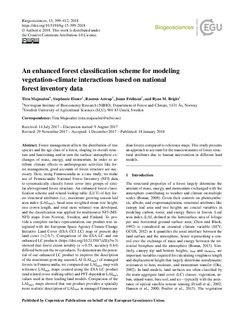| dc.description.abstract | Forest management affects the distribution of tree species and the age class of a forest, shaping its overall structure and functioning and in turn the surface–atmosphere exchanges of mass, energy, and momentum. In order to attribute climate effects to anthropogenic activities like forest management, good accounts of forest structure are necessary. Here, using Fennoscandia as a case study, we make use of Fennoscandic National Forest Inventory (NFI) data to systematically classify forest cover into groups of similar aboveground forest structure. An enhanced forest classification scheme and related lookup table (LUT) of key forest structural attributes (i.e., maximum growing season leaf area index (LAImax), basal-area-weighted mean tree height, tree crown length, and total stem volume) was developed, and the classification was applied for multisource NFI (MSNFI) maps from Norway, Sweden, and Finland. To provide a complete surface representation, our product was integrated with the European Space Agency Climate Change Initiative Land Cover (ESA CCI LC) map of present day land cover (v.2.0.7). Comparison of the ESA LC and our enhanced LC products (https://doi.org/10.21350/7zZEy5w3) showed that forest extent notably (κ = 0.55, accuracy 0.64) differed between the two products. To demonstrate the potential of our enhanced LC product to improve the description of the maximum growing season LAI (LAImax) of managed forests in Fennoscandia, we compared our LAImax map with reference LAImax maps created using the ESA LC product (and related cross-walking table) and PFT-dependent LAImax values used in three leading land models. Comparison of the LAImax maps showed that our product provides a spatially more realistic description of LAImax in managed Fennoscandian forests compared to reference maps. This study presents an approach to account for the transient nature of forest structural attributes due to human intervention in different land models. | nb_NO |

